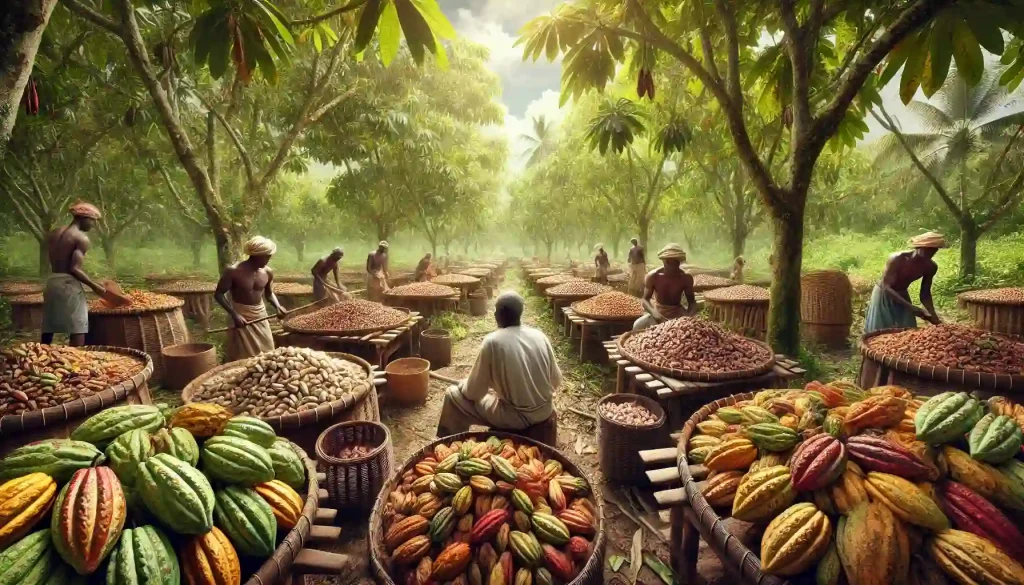From Bean to Export
Africa is the heart of the global cocoa industry, producing nearly 70% of the world’s cocoa beans. Countries such as Ivory Coast, Ghana, Nigeria, and Cameroon are renowned for their high-quality cocoa, which is the key ingredient in chocolate and many other products. The process of cocoa production in Africa is a complex journey that begins on small farms and ends with the export of cocoa beans to chocolate manufacturers around the world.
The Cocoa Production Process
The production of cocoa in Africa involves several critical stages, from growing and harvesting the beans to fermenting, drying, and preparing them for export. Each stage plays a vital role in ensuring the quality of the final product.
Cultivation and Growing
The journey of cocoa begins with the cultivation of cocoa trees (Theobroma cacao), which thrive in the warm and humid tropical climates of West and Central Africa. The trees require a delicate balance of sunlight and shade, often growing in shaded areas under the canopy of larger trees. African farmers, most of whom work on small family-owned farms, tend to these trees carefully, ensuring they remain healthy and productive.
Varieties of Cocoa: The main types of cocoa grown in Africa are Forastero, Criollo, and Trinitario, with Forastero being the most common due to its hardiness and high yield.
Sustainability: In recent years, there has been a growing focus on sustainable cocoa farming in Africa. Programs aimed at improving farming techniques, ensuring fair wages, and reducing deforestation are becoming more common.
Harvesting
Cocoa trees begin to bear fruit after about 3 to 5 years. The fruit, known as a cocoa pod, contains seeds (cocoa beans) that are encased in a sweet, white pulp. Harvesting typically occurs twice a year, with the main harvest taking place during the dry season.
Manual Harvesting: Farmers manually cut the ripe cocoa pods from the trees using machetes or other sharp tools. This delicate process is done by hand to avoid damaging the pods or the trees.
Fermentation
Once harvested, the beans and the surrounding pulp are removed from the pods and placed in shallow containers, baskets, or laid on banana leaves for fermentation. This stage is crucial in developing the rich flavor and aroma of the cocoa beans.
Natural Fermentation: During fermentation, the sugars in the pulp break down, generating heat and creating the flavor compounds that will define the taste of the chocolate. Fermentation usually lasts between 5 to 7 days.
Variety Impacts: Different cocoa varieties require slightly different fermentation times and techniques, which can significantly affect the quality and taste of the cocoa beans.
Drying
After fermentation, the beans need to be dried to reduce their moisture content and preserve them for export. This process typically takes place in the open air under the sun, where the beans are spread out on large mats or raised platforms and regularly turned to ensure even drying.
Sun Drying: The beans are dried for several days (usually around 5-10 days), until they reach the proper moisture content, which should be around 7%. Proper drying is essential to prevent mold and ensure that the beans retain their rich flavor.
Sorting and Grading
Once dried, the beans are sorted and graded based on size, appearance, and overall quality. This ensures that only the best beans are selected for export. African farmers and cooperatives often work closely with exporters to ensure that the beans meet international standards.
Quality Control: During the grading process, any defective or damaged beans are removed. High-quality cocoa beans are essential for producing premium chocolate products, and Africa is known for producing some of the world’s best.
Exporting
After the beans have been dried and graded, they are packed into sacks or bulk containers and transported to ports for export. Africa’s major cocoa-exporting countries, such as Ivory Coast and Ghana, have well-established infrastructure to ensure that the beans reach their destinations in Europe, Asia, and North America.
Global Cocoa Market: Africa’s cocoa beans are primarily exported to chocolate manufacturers in countries like Switzerland, Belgium, and the United States, where the beans are processed into chocolate, cocoa powder, and other cocoa products.
Challenges in African Cocoa Production
While Africa remains the world’s leading cocoa producer, the industry faces several challenges, including:
Climate Change: Rising temperatures and unpredictable rainfall patterns are affecting cocoa production, making it harder for farmers to predict yields and maintain crop health.
Sustainability: There is increasing pressure on cocoa-producing countries to adopt more sustainable practices, reduce deforestation, and ensure fair wages for farmers. Many African nations are now working with international organizations to promote sustainable cocoa farming.
Child Labor: In some regions, the cocoa industry has been criticized for using child labor. Governments and NGOs are collaborating to eradicate child labor and improve working conditions for all cocoa farmers.
The Future of Cocoa in Africa
Despite these challenges, the future of cocoa production in Africa looks promising. The growing global demand for chocolate and the increasing interest in sustainable and ethical sourcing practices are driving investments in the region. Programs aimed at improving yields, providing education and training for farmers, and ensuring fair trade practices are helping to build a more sustainable future for cocoa in Africa.
By continuing to innovate and improve their farming practices, African cocoa producers are well-positioned to meet the needs of a growing global market while ensuring that their local communities benefit from the fruits of their labor.




